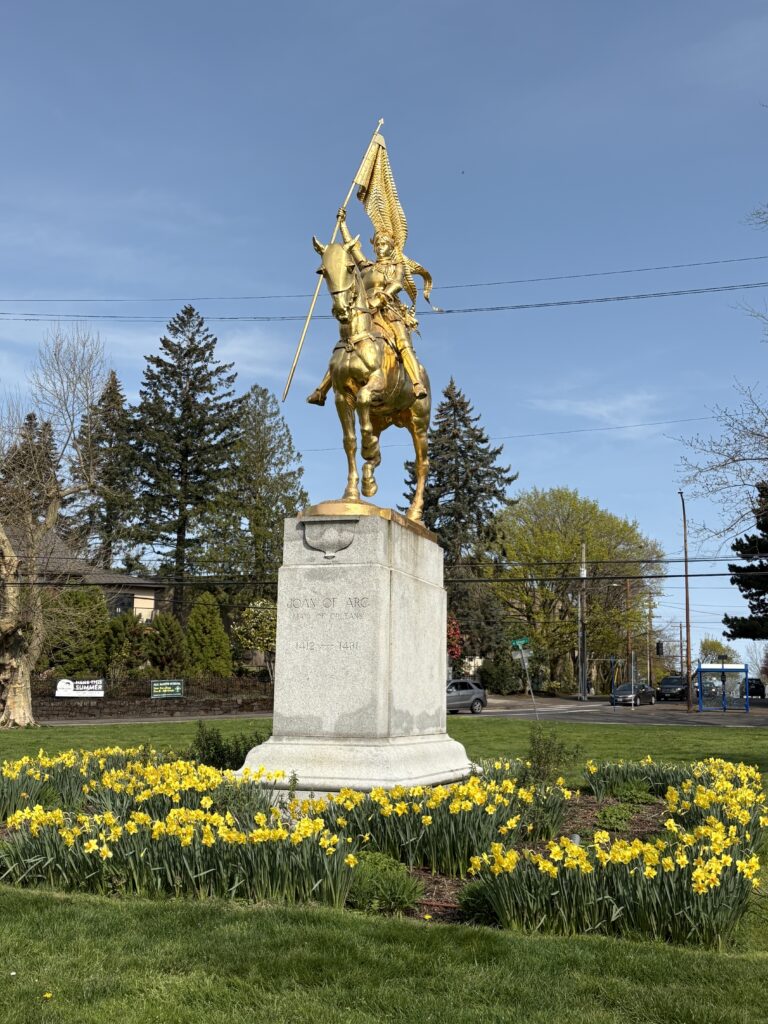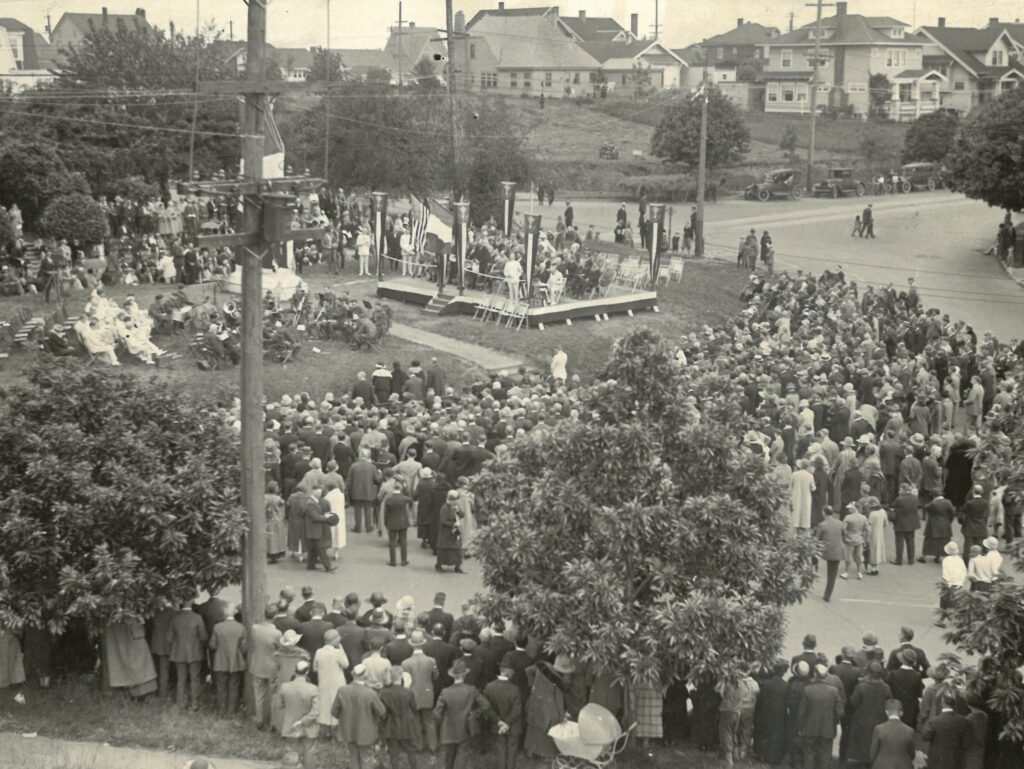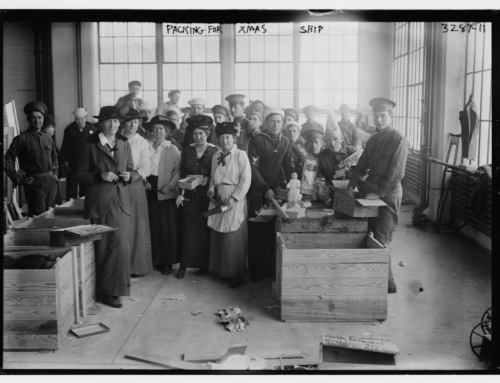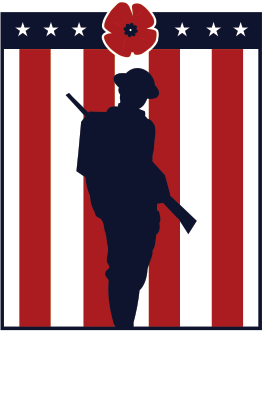Centennial Event Honors Portland, OR Joan of Arc Statue & American Doughboys
Published: 25 April 2025
By Kelly Ann Wiggins
Special to the Doughboy Foundation website
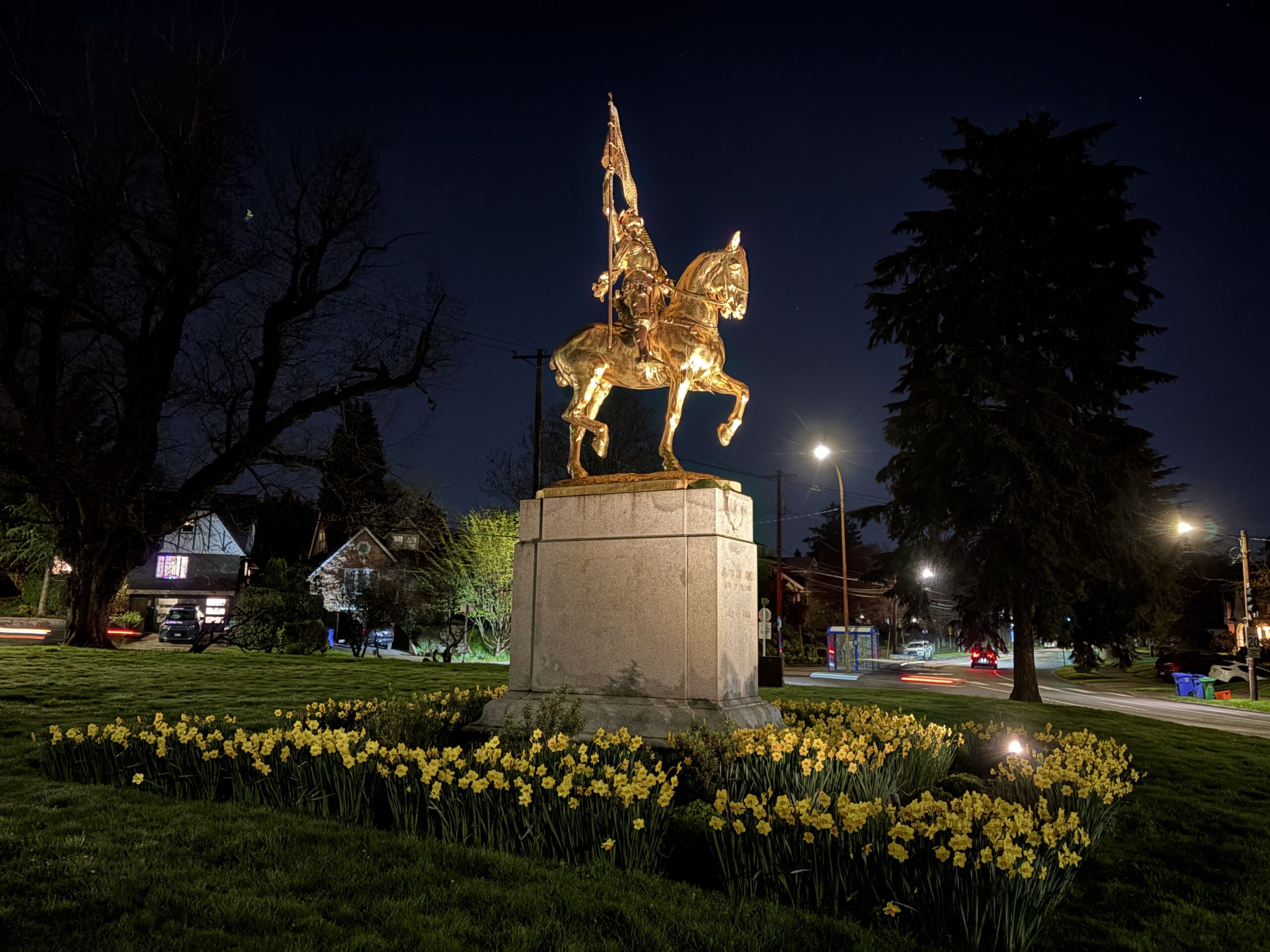
Joan at Night (credit Aubrey Russell)
(Photo by Aubrey Russell)
On Memorial Day, May 30, 1925, a large crowd gathered for the dedication of the Joan of Arc statue that graces Coe Circle in the Laurelhurst neighborhood of Portland, Oregon. It was erected to honor American infantrymen, also known as Doughboys of World War I, and the United States’ long-standing alliance with France. The story told back then that along with the French forces, the Doughboys viewed Joan of Arc as their patron saint and it is said they would sing “Joan of Arc, They Are Calling You” as they would march into battle.
This year on Friday, May 30, 2025 — exactly one hundred years later — the Multnomah-Portland Chapter is planning a rededication celebration where the community will gather once again to celebrate the statue’s centennial. Memorial Day no longer falls on May 30th, however this date is also significant as it is the feast day of Saint Joan of Arc.
Founded in 1896, the Multnomah-Portland Chapter, National Society Daughters of the American Revolution (NSDAR or DAR) is a women’s service organization focused on historic preservation, education, and patriotism. The NSDAR originally created the Franco-American Memorial Committee in the late 1890’s as an auxiliary to the DAR Franco-American Commission, with the purpose of erecting monuments in Paris of Generals Washington and Marquis de Lafayette and other French heroes who gave service to America during our fight for freedom.
The committee has been reestablished to honor the long history of the American and French alliance, as well as celebrate the 200th anniversary of Lafayette’s Farewell Tour that took place from 1824 to 1825. It is also working to honor the Franco-American Patriots who fought for American independence, and Americans who in turn fought along with the French troops during World War I. Part of the committee’s initiatives is recognizing the many statues and memorials across the country that were erected in honor of our French-American alliance, such as the Joan of Arc in Coe Circle and several others in Oregon.
Dr. Henry Waldo Coe was quoted as saying, “Besides this, there are those traditions of mutual friendship which the people of the United States and France always have kept alive, and which never should be allowed to die.”[1] Through this event, we continue to honor our French-American alliance, the Doughboys, Joan of Arc and those who paid the ultimate sacrifice for freedom.
It was in February 1924 that Dr. Coe announced his plans to donate the statue, the second of four that he would give to the City of Portland. On his several visits to Paris he was so impressed with the many bronze statues that wanted to see the same for Portland, saying, “I would like to see Portland become the city of bronzes as well as the city of roses…”[1] He wanted to not only promote patriotism and honor the Doughboys, but bring monuments to Portland, like those in other major cities.
Dr. Coe consulted with many art authorities, including the famous American sculptor George Fite Walters, regarding the selection of the equestrian statue because there were two in Paris — one sculpted by Paul Dubois in 1889 and the other by Emmanuel Frémiet in 1874. Dr. Coe’s sister, Elizabeth Waggoner, an artist living in Paris, provided her insight as well. He ultimately chose the statue by Frémiet as the one to be replicated and brought to Portland. [1]
When Dr. Coe and his wife visited Le Marquis de Dampierre, a lineal descendent of General La Fayette, 1 and the marquis stated, “The statues by Frémiet is one of our most honors shrine here in France.” He would continue to say, “In May on the Fest of Jeanne d’Arc, all Paris gathers to pay tribute to their beloved heroine. The statue is covered with garland and flowers. And we are grateful to think that our sentiments are to be kept alive in a great American city on the Pacific Coast.” [1]
The statue, cast from the original mold of the 1874 statue Jeanne d’Arc by Frémiet, arrived in Portland from France during the summer of 1924 . Originally Dr. Coe left the location of the statue to the city to decide but given the statue’s revered status in France and his previous consultations, he became pivotal in its final location. The statue was unplaced for some time, in part due to Dr. Coe not being satisfied with the proposed location of Laurelhurst Park where the large trees could potentially damage the statue. His recommendation of another location in downtown Portland was opposed by a member of the Art Commission; and other locations were considered and rejected including Ladd’s Circle in the Ladd’s Addition neighborhood. [2] Ultimately, a small park in a roundabout located in the Laurelhurst neighborhood in southeast Portland would become its home and aptly named Coe Circle, after Dr. Coe.
A grand event to unveil the statue was held in this small intersection, attended by a large crowd opening with the singing of the National Anthem. In attendance were several city leaders along with the French consulate who shared the significance of the date for the event, Memorial Day, as a day also recognized by the French in recognition of the Americans who made the ultimate sacrifice in France. Telegrams from President Calvin Coolidge and French President Gaston Doumergue were read followed by the singing of “The Marseillaise”. Also in attendance, Major General Ulysses Grant McAlexander, “The Rock of the Marne,” who gave his address closing with the formal dedication of the statue of Joan of Arc to the American Doughboys on behalf of Dr. Coe. Among others, Oregon Governor, Walter Marcus Pierce, addressed the crowd. The event ended with the Portland Royal Rosarian’s singing “Joan of Arc, They Are Calling You”, followed by the American Legion drum corps and a benediction. [3] [4]
The impressive bronze statue covered in gold leaf stands nearly 12 feet tall, maybe more, and sits on a granite base that measures 8 feet by 3 feet by 9 feet tall. On the base, the inscription reads “Joan of Arc, Maid of Orleans 1414 – 1431”. The pennant flag held by Joan of Arc is made of copper. After many decades of enduring the elements, in 2002 the flag and wreath on Joan of Arc’s head, along with the gold leaf covering the entire statue, was replaced and the statue was fully restored.[5]
The Multnomah-Portland chapter hopes to replicate the original event for the event this May 2025, having many of the same organizations present, including the Royal Rosarians, members of the Art Council, the Alliance Francaise de Portland, and more. The Laurelhurst Neighborhood Association is also supporting the event, with many other individuals contributing.
The following piece has been prepared for the event by an author who wishes to remain anonymous, and it will be presented by a member of a local chapter from the Veteran of Foreign Wars. I believe it’s a powerful and fitting tribute to the brave Doughboys, and I am honored to share it with you.
“The Fire That Does Not Die”
In the shadow of that solemn monument, let’s pause to remember a different kind of battlefield. Not the fields and fortresses of medieval France, but a harsher, more haunting landscape — etched with trenches, barbed wire, and the scars of mechanized warfare. It was there, a century ago, that the world was plunged into the crucible of the Great War, when the very earth shook beneath the thunder of artillery, and the skies blazed with fire and smoke. This was not a war of knights and banners, but of mud and gas, of courage in the face of horror, and sacrifice beyond reckoning. Today, as we gather together in celebration, we honor the memory of those who endured the unimaginable, who stood firm amid the storm, and who now rest beneath the soil they once fought to defend. In that war, American sons crossed the ocean not to conquer, but to defend. They came from every corner of our young nation: from Appalachian farms, New York tenements, and prairie towns with no names known to maps. They left behind mothers, sisters, sweethearts — and stepped into a crucible unlike anything their generation had ever known.
The Doughboys arrived in France filled with resolve and enthusiasm. They could not comprehend the horrors that awaited them. Their eager trusting eyes scanned the shattered landscape, still innocent to the reality of war. Letters from home, brass buttons polished to a shine, and laughter that still came easily — all would fade in the years ahead.
The trenches were narrow scars etched across a devastated land, as though the earth itself had tried to claw away from the violence. Lined with rotting timber and slick with slime, they offered no shelter from the constant threat of death. Mud and blood mixed underfoot into a thick, sucking mire that swallowed boots and blurred the line between the living and the dead.
The air hung heavy with the stench of cordite and chlorine, acrid and clinging to every breath. Gas masks, if they could be found in time, were their only defense against the yellow-green clouds that drifted with the breeze.
The roar of artillery never ceased. Shells fell day and night, churning earth into chaos, splintering trees into skeletal stumps, and leaving behind craters big enough to drown in. The ground never seemed to stop trembling.
In that place, time blurred. Days became a procession of monotony and terror — stand-to at dawn, fear at dusk, and a grim hope that maybe, just maybe, they’d survive to see the sun rise one more time.
But still — they stood fast.
They stood fast through freezing nights in waterlogged trenches, fingers numb, and uniforms soaked. They stood shoulder to shoulder in the mud at Belleau Wood, charging into machine gun fire with nothing but grit and bayonets. At Meuse-Argonne, they climbed over the top, time and time again, in the largest American offensive ever mounted. They carried the wounded. They buried the dead. They endured.
They endured because, like Joan, they believed in something beyond themselves.
They fought not for conquest — but for liberty.
Not for glory — but for peace.
Not for reward — but for righteousness.
And in this way, Joan of Arc and the Doughboys are kindred spirits. Though separated by centuries, they are united by something eternal — a calling that echoes across time. Both heard the same voice, not always with their ears, but deep within their souls. It was the call to protect home, to shield the innocent, to push back against darkness — no matter how overwhelming it seemed, no matter how small they felt in the shadow of it.
Joan’s banner bore the symbol of divine purpose, a flame of hope held high above chaos. Her sword was not drawn for conquest or revenge, but for a deeper cause — for faith, for justice, for the deliverance of her people. When she rode into battle, it was never for glory. It was for the soul of France, for villages tucked behind hills, for children who deserved peace.
So too did the young men who crossed oceans and filled the trenches. Those American Doughboys carried more than rifles — they carried letters from home, prayers tucked in pockets, a fierce belief that what they were doing mattered. They stood in mud and wire for something larger than themselves. And like Joan, they knew the cost of conviction. Like her, they bore that burden with grace, with grit, and with fire in their hearts.
Both were young. Both were brave. Both were guided by a light that others could not always see. But they saw it clearly. And because of that, they moved forward — one on horseback, the others in steel helmets and hobnailed boots — each refusing to yield.
Today, as we stand in the presence of her image, cast in bronze but alive in spirit, we honor both the Maid of Orléans and the American doughboy. We remember their courage, not as myth, but as fact. Not as distant, but as enduring. For the flame they lit has not gone out.
It lives in the freedoms we cherish.
It lives in every act of service.
It lives in the quiet strength of remembrance.
The fields they walked are silent now.
The trenches are long gone.
But listen closely — and you will hear it:
The whisper of angels in uniform.
The rustle of a banner in the wind.
The fire that does not die.
May we live lives worthy of their memory.
May we teach our children what they stood for.
And may we always, always carry forward the light they left behind.
God Bless America!
Kelly Ann Wiggins is the Regent of the Multnomah-Portland Chapter, National Society of the Daughters of the American Revolution. www.multnomahchapternsdar.org
Notes:
[1] The Sunday Oregonian February 24, 1924
[2] Morning Oregonian on October 25, 1924
[3] Oregon Daily Journal on Saturday, May 30, 1925
[4] The Sunday Oregonian on Sunday, May 31, 1925
[5] Wikepedia.org. Equestrian statue Joan of Arc (Portland, Oregon). February 22, 2025. https://en.wikipedia.org/wiki/Equestrian_statue_of_Joan_of_Arc_(Portland,_Oregon)
External Web Site Notice: This page contains information directly presented from an external source. The terms and conditions of this page may not be the same as those of this website. Click here to read the full disclaimer notice for external web sites. Thank you.
